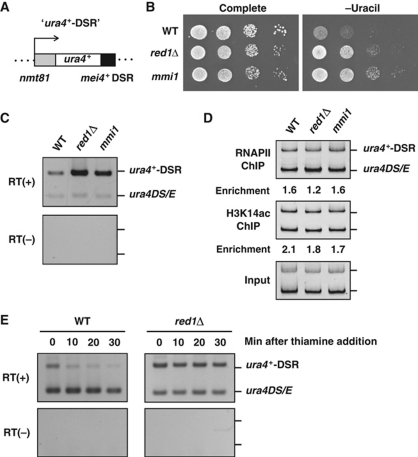Figure 5.
Red1 promotes the destabilization of DSR-containing mRNA. (A) Schematic representation of the ura4+-DSR construct. The DSR region derived from mei4+ was fused to the ura4+ gene and this ura4+-DSR mRNA was driven by the nmt81 promoter, which was repressed in the presence of thiamine. This construct was integrated into the lys1+ locus. (B) red1Δ led to the ‘ura4+-on’ state in cells carrying the ura4+-DSR construct. Serial dilutions of wild-type (WT), red1Δ, and mmi1-619 (mmi1) cells containing the ura4+-DSR construct were spotted onto a complete or uracil-lacking plate and then incubated for 3–4 days at 30°C. (C) The ura4+-DSR transcript accumulates in red1Δ and mmi1-619 cells. Wild-type, red1Δ, and mmi1-619 cells carrying both the ura4+-DSR construct and a ura4+ minigene (ura4DS/E) were grown in the absence of thiamine and then subjected to RT–PCR analysis using a ura4+ primer set that amplifies both ura4+-DSR and ura4DS/E. The ura4DS/E was used as the internal control. (D) red1Δ does not increase RNA polymerase II (Pol II) occupancy or the levels of histone H3 Lys14 acetylation (H3K14ac). Wild-type, red1Δ, and mmi1-619 cells expressing both ura4+-DSR and ura4DS/E were subjected to chromatin immunoprecipitation using anti-Pol II and anti-H3K14ac antibodies. The precipitated DNAs were analysed by PCR using the same primer described in (C). (E) The ura4+-DSR became more stable in red1Δ compared with wild-type cells. Thiamine was added to the culture of wild-type or red1Δ cells grown without thiamine, and then the levels of ura4+-DSR and ura4DS/E transcripts were examined by RT–PCR.

